![]()
![]()
![]()
Use LEFT and RIGHT arrow keys to navigate between flashcards;
Use UP and DOWN arrow keys to flip the card;
H to show hint;
A reads text to speech;
17 Cards in this Set
- Front
- Back
|
In modern supply chains ____ replaces inventory.
Why? |
Information
Why? Because with more information about demand / preferences, companies can save on holding costs by keeping inventory to a minimum |
|
|
How should the information in SCM be?
|

|
|
|
What are the 3 SCM macro-processes? Explain.
|
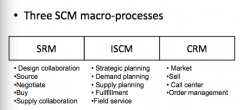
SRM = Supplier Relationship Management
ISCM = Integrated Supply Chain Management CRM = Customer Relationship Management |
|
|
What is the difference with information technology in SCM between the past and now?
|
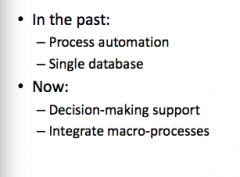
|
|
|
What are the 2 basic IT approaches to SCM?
|
1. "Best of Breed"
2. Single Software |
|
|
What are the IT risks to SCM?
|
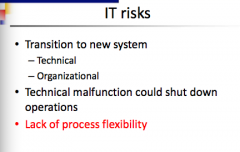
|
|
|
What are the IT risk solutions for SCM?
|
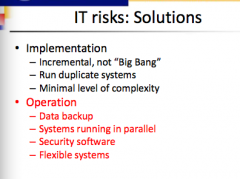
|
|
|
Explain 3 likely happenings in the future of IT in supply chaines?
|
1. Growth of software as a service (SaaS)
2. Increased availability of real-time data 3. Increased use of mobile technology |
|
|
What are the steps to using supply chain IT in practice?
|
1. Select an IT system that addresses the company's key success factors
2. Take incremental steps to measure value 3. Align the level of sophistication with the need for sophistication 4. Use IT systems to support decision-making, not to make decisions 5. Think about the future |
|
|
Talk about sustainability in supply chains. What are sustainable supply chains referred to as?
|
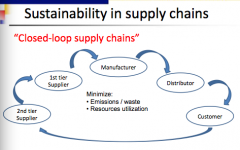
Closed-loop supply chains
|
|
|
What are the 4 main components to creating a "Green Supply Chain"?
|
1. Suppliers
2. Transportation 3. Localization 4. Packaging |
|
|
How can suppliers contribute to a green supply chain?
|
Through monitoring and collaboration.
Monitor: questionnaires, ISO rules, certifications, audits (e.g. Starbucks buys from Coffee and Farmer Equity certified suppliers or Ikea says that every supplier must receive an audit before the first shipment) Collaboration: 1. teach how to use resources more effectively 2. joint process redesign 3. Follow-up periodically Example was coke who wanted to reduce its water footprint to produce one liter of coke and did it via drip irrigated sugarcane or H&M wanted to better the evironmental impact of fabric production, and so H&M auditors incentivized factories to switch to cleaner production processes at dye houses and performed follow up on it. |
|
|
How can transportation contribute to a green supply chain?
|
Via clean transport modes. E.g. UPS uses carbon neutral shipping with fuel-efficient airplanes, lower flight speeds, alternative fuels, and routing software.
|
|
|
How can localization contribute to a green supply chain?
|
Local sourcing reduces the amount of transportation that you need
|
|
|
How can packaging contribute to a green supply chain?
|
1. Less material
2. Recyclable 3. Reusable |
|
|
What is visibility / traceability in the context of sustainable supply chains?
|
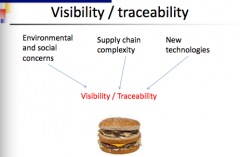
Being able to trace and see the environmental and social impacts of your product within the complexity of its supply chain using new technologies.
|
|
|
How can a company increase traceability in its production / distribution?
|
Using RFID tags for product tracking and inventory management
-OR- companies can use QR codes |

